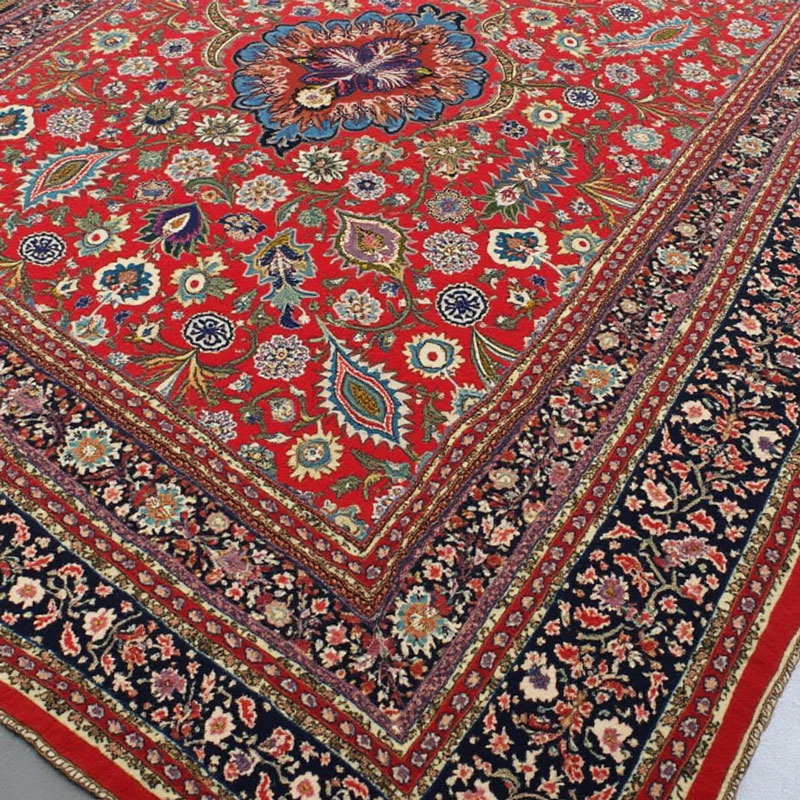If you are looking to purchase a hand-knotted Persian rug or a good machine-made one, knowing some important points in advance will enable you to get the best value for your money. In the following, we explain 10 things to know before buying a persian rug to make the best decision.
10 Important Things for Buying a Persian Rug
Persian rugs are renowned all over the world for their excellent craftsmanship, intricate designs, and unparalleled quality.
1. Understand the Difference Between Handmade and Machine-Made Rugs
To start with, you have to make a choice about whether you like a hand-knotted Persian rug or a machine-made Persian rug. Handmade rugs are constructed by master artisans and will last for centuries, whereas machine-made rugs are less expensive but lack the special attributes of handmade pieces. Handmade rugs also gain value as time passes.
2. Check the Knot Density (KPSI)
The quality of a Persian rug is typically determined by the density of its knots in knots per square inch (KPSI). The more densly knotted, the greater the detail of the design. As a general rule, handmade rugs with over 120 KPSI are high quality and some superior specimens over 500 KPSI.
3. Know the Different Types of Persian Rugs
Persian rugs come in many varieties, designs, and patterns as well as local motifs. The most sought-after Persian rug varieties include:
· Tabriz Rugs: Renowned for their floral patterns and tight knots
· Isfahan Rugs: Rich, silk foundation and symmetrical design
· Kashan Rugs: Famous for their medallion patterns and deep red coloration
· Qom Silk Rugs: Made of pure silk, offering a sophisticated and silky texture Familiarity with these differences will help you to choose the rug that best fits your taste.
4. Examine the Materials Used
Persian rugs are produced in various kinds of material including wool, silk, and cotton. Delicate rugs are typically produced from:
• Wool: Soft, resistant, and suitable for heavy usage areas
• Silk: Fine, luxurious, and delicate, ideal for being used in decoration
• Cotton: Used most commonly in the foundation for its strength
Be cautious of the synthetic ones since they are commonly less potent and fail to present the depth found with natural fibers.
5. Analyze the Colors and Dyes
Real Persian rugs are dyed using natural dyes derived from plants, insects, and minerals that give deep, rich hues, which age beautifully. You can test for natural dyes by rubbing a damp white cloth gently against the rug. If the color runs, it may have been dyed using synthetic chemicals, which are not durable.
6. Identify Authenticity and Avoid Counterfeits
Even though Persian rugs are so popular, the imitations have saturated the market. In order to determine authenticity:
• Get a hand-knotted rug instead of a printed or glued rug
• Check for irregularities at the back; handwoven rugs are not perfectly uniform
• Check the origin by looking at labels or requesting documents
• Buy from reputable dealers or certified rug sellers
7. Consider the Rug’s Size and Placement
Measure the space where you plan to place the rug prior to purchasing it. Persian rugs come in small accent rug sizes to room-size rugs. Standard sizes include:
• 4'x6': Ideal for small areas like entrances
• 6'x9': Suitable for medium rooms
• 9'x12' and larger: Suitable for big living rooms and dining rooms The right-sized rug contributes to the aesthetics of a room and enhances the décor therein.
8. Compare Prices and Set a Budget
Persian rugs can cost anywhere from a few hundred to several thousand dollars based on material, knot count, and handiwork. Compare prices among sellers and decide on a budget that suits your requirements before purchasing. Keep in mind that handmade rugs are more costly but pay dividends in the long run.
9. Learn About Proper Maintenance and Cleaning
Owning a Persian rug is a big responsibility when it comes to taking care of it. To keep your rug in its optimal condition:
• Vacuum regularly but without the beater bar
• Rotate the rug every few months for uniform wear
• Keep it away from direct sunlight to avoid fading
• Clean spills immediately with mild soap and water
• Professional cleaning every few years might be an option
10. Choose a Trusted Seller
Whether you're buying from a local rug dealer, an online market, or an Iranian bazaar, make sure you're buying from a trusted source. Trusted sellers offer authenticity guarantees, transparent return policies, and transparent pricing. If possible, ask for a certificate of authenticity to confirm the origin and quality of the rug.
Frequently Asked Questions (FAQs)
- How can I tell if a Persian rug is handmade?
Handmade Persian rugs have tiny irregularities in the weave, uncovered knots on the back, and are never symmetric. You may also examine the fringe; handmade rugs have fringes that continue from the foundation of the rug.
- Are Persian rugs a good investment?
Yes, high-quality Persian rugs appreciate in value, especially antique and silk rugs. Their beauty and cultural significance make them a highly sought-after collector's item.
- How long does a Persian rug last?
A Persian rug, if well taken care of, will last for centuries. Hand-knotted wool rugs, in particular, are extremely durable and can withstand decades of wear and tear.
- Why are Persian rugs so expensive?
The price of Persian rugs reflects their craftsmanship, natural materials, and the time-intensive process of hand-knotting each piece. Some rugs take months or even years to complete, adding to their value.
- Can I place a Persian rug in a high-traffic area?
Yes, wool Persian rugs are very durable and can handle high foot traffic. Silk rugs, on the other hand, are more fragile and are best used for decorative or low-traffic purposes.
In conclusion
Buying a Persian rug is a significant investment that should be thought through. Through these 10 essential tips, you can choose a rug that enhances your room's beauty, reflects your personal style, and provides lasting value.
When purchasing a timeless handmade Persian rug or a high-end machine-made Persian rug, making an educated decision ensures that you take home a timeless work of art that will delight you for years to come.

